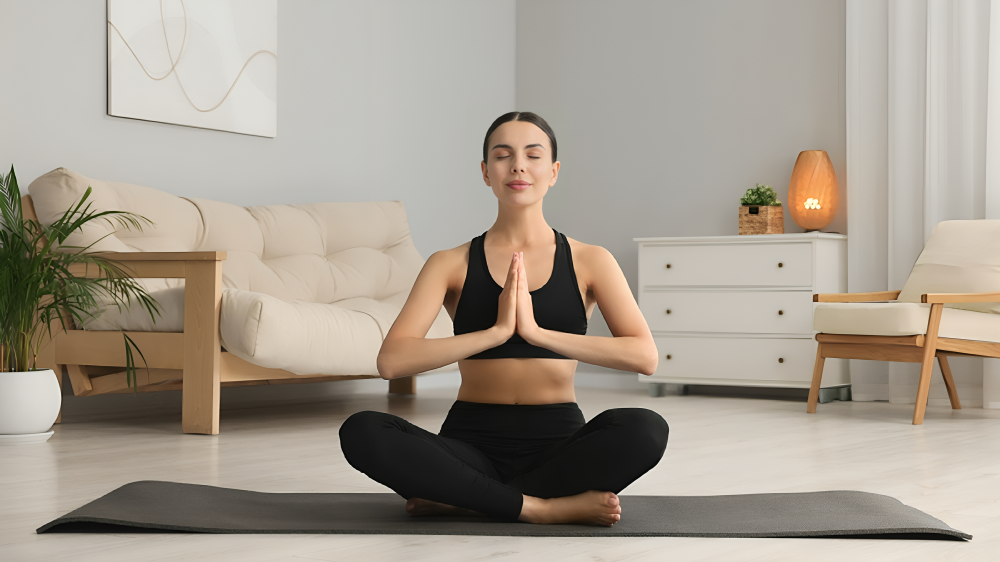
What is Vritti Pranayama?
Essentially, Vritti Pranayama focuses on “vrittis,” which refers to an agitated or modified mind in yogic philosophy. The goal of Vritti Pranayama is to stabilize these agitations by focusing on the rhythm of your breath. It all comes down to equalizing puraka-inhalation and rechaka-exhalation, or one’s kumbhaka-retain of breath at key moments. This exercise is not just about deep breathing but about precise control over each and every breath taken.
How to Practice Vritti Pranayama
Find a Comfortable Position
Sit in a comfortable seated position like Sukhasana – easy pose or Padmasana – lotus pose.
Keep the spine straight and the shoulders relaxed. Your hands can rest on your knees in a mudra, such as Gyan Mudra, with your thumb and index finger touching.
Begin with Natural Breathing
Take a few moments and simply breathe. Close your eyes, let your attention fall to the rhythm of your breath. It helps the mind settle, and the body gets prepared for what is going to happen.
Set a Breathing Ratio
Start with a simple breathing ratio, like 1:1, meaning equal inhalation and exhalation. For example, inhale for 4 counts and exhale for 4 counts.
When you feel comfortable, try more progressive ratios, such as 1:2, where the exhale is longer than the inhale by a factor of two.
Practice Samavritti (Equal Breathing)
Inhale deeply through your nose to the count of 4.
Exhale to the same count (4).
Repeat for approximately 5-10 minutes. Keep your attention on equal length of time during inhalation and exhalation.
Practice Visamavritti (Unequal Breathing)
When you are comfortable with poorna breathing, you can do Visamavritti, in which you make one of them longer-the inhalation or exhalation.
The most common way is to inhale for a count of 4 and exhale for a count of 6 or 8.
This can be a deeper relaxation through the lengthening of your exhalation, which also turns on the parasympathetic nervous system.
Optional: Add Kumbhaka (Breath Retention)
For those more advanced, include the addition of kumbhaka, or retention of the breath after inhaling or exhaling. As an example, inhale on a count of 4, retain the breath for 2 counts, and then exhale on a count of 6.
Gently-and never force-your retention of breath, and if you start to dizzy or become uncomfortable, release the retention and continue into equal breathing.
Finish with Natural Breathing
After your session, return to natural breathing for a minute or two, before slowly opening your eyes. This helps you re-ground yourself before finishing your practice.
Benefits of Vritti Pranayama
Reduces Stress and Anxiety
Breathing exercises like Vritti Pranayama have a direct impact on the nervous system. Slowing down your breath allows for your body’s relaxation response to come into play, hence reducing levels of stress and anxiety.
Improves Focus and Mental Clarity
It does this by calming the fluctuations of the mind through regulation of the breath, which enhances the ability to focus, concentrate, and become more clear-headed. For this reason, it is ideal to practice before meditation or any mentally intensive activity.
Balances the Nervous System
Vritti Pranayama tends to fire up both the sympathetic (fight-or-flight) and parasympathetic (rest-and-digest) nervous systems in a balanced manner. This fosters a healthy emotional condition in a stable state.
Improves Lung Capacity
Like all pranayama, Vritti strengthens your lungs and increases their capacity. This is great, especially for any person suffering from some respiratory problem or for anybody wanting to increase their overall lung capacity.
Emotional Balance
Since the breath directly affects the nervous system, Vritti Pranayama helps balance the emotions so that one remains calm in odd situations.
Improves Quality of Sleep
Extended exhalations and retention of breath are soothing, and hence, would improve your sleep. You can always use Vritti Pranayama as a bedtime practice to fall asleep since it relaxes you.
It’s Here Sahita Kumbhaka Pranayama How to do it and what are the benefits
FAQs
Q1. How often should I practice Vritti Pranayama?
You should ideally practice Vritti Pranayama daily for a duration of 10-15 minutes to experience its optimum benefits. You can increase the duration as you get used to your own rhythm.
Q2. Would a beginner be able to practice Vritti Pranayama?
Definitely! Beginners can start with simple equal breathing Samavritti and then move on to more advanced techniques like Visamavritti and kumbhaka.
Q3. What time of the day is considered most appropriate for practicing Vritti Pranayama?
You can do this at any time but, for the real calming effect, it is best if you do it early in the morning or right before bedtime

